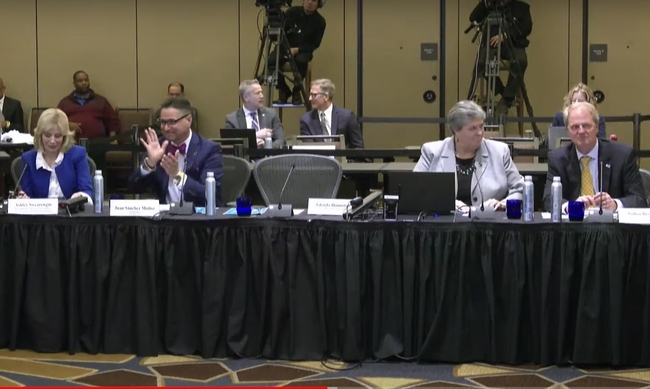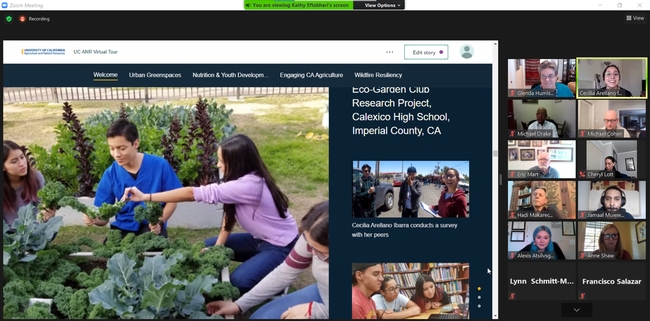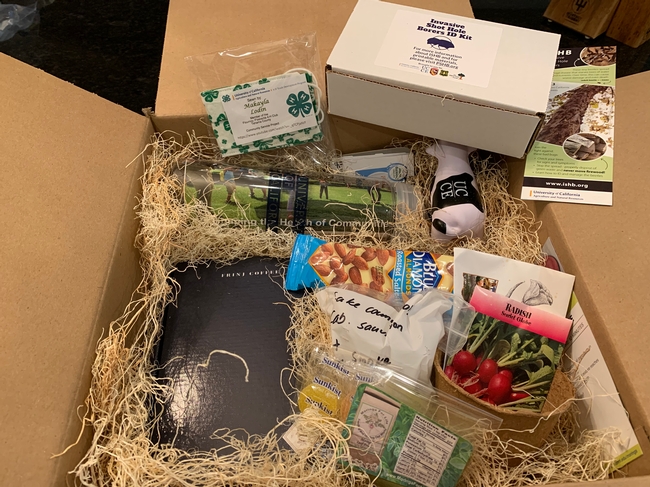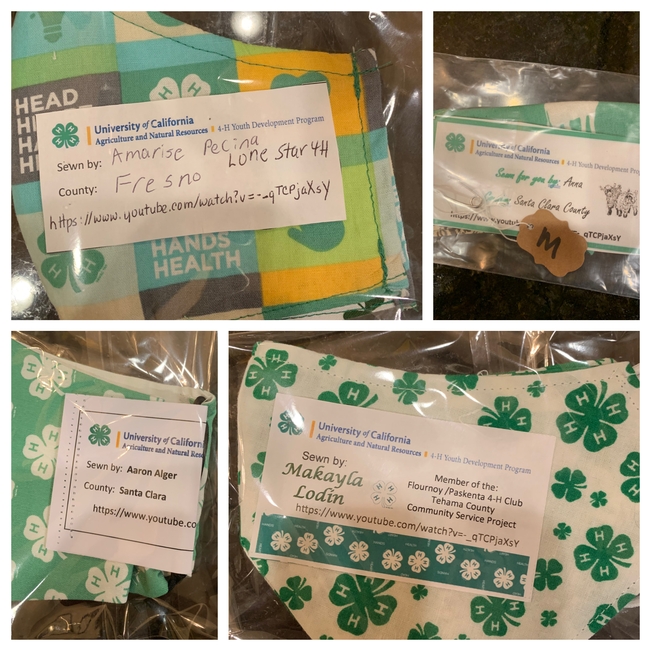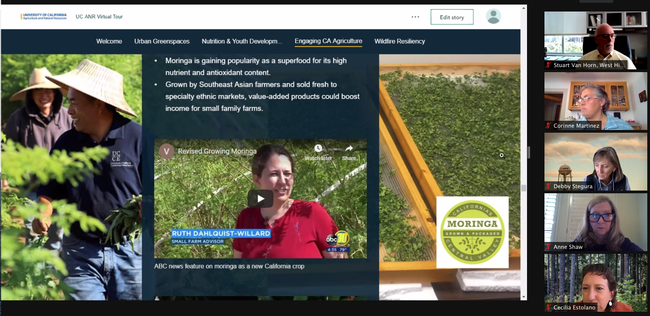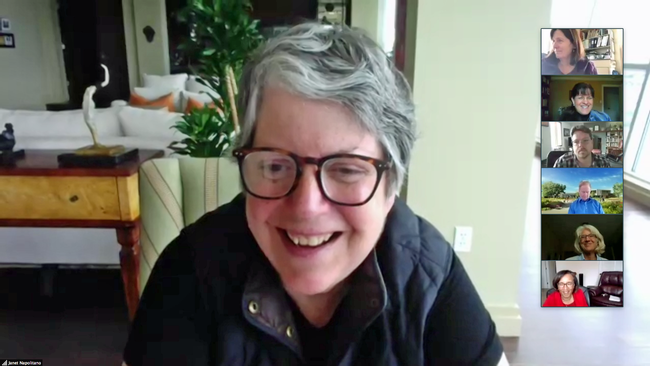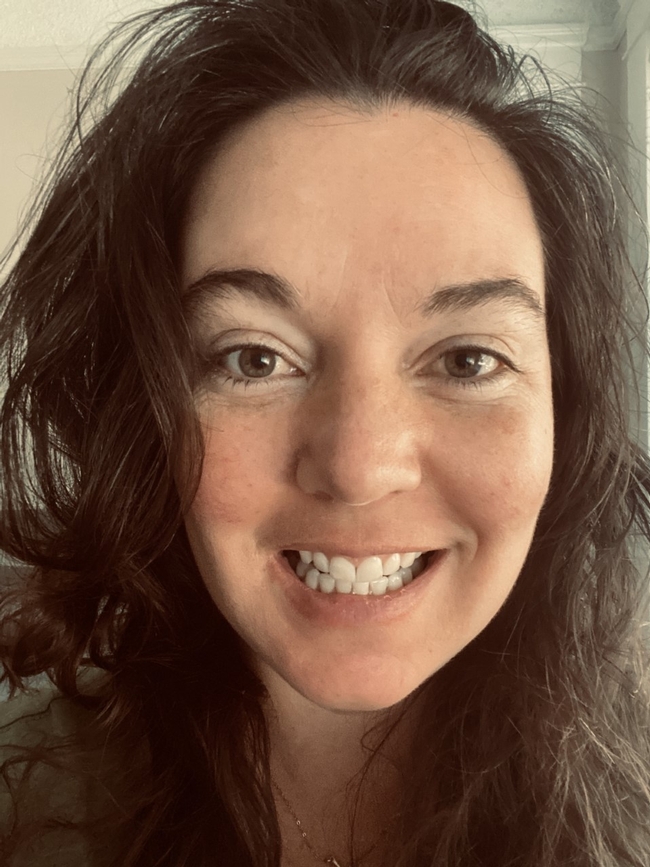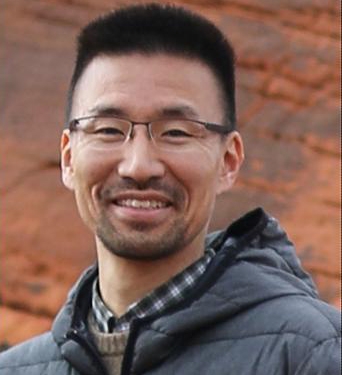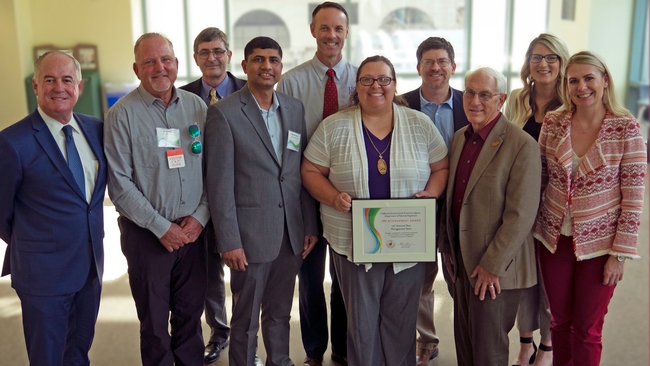Posts Tagged: UC regents
Central Valley agrifood initiative F3 receives major boost
The Fresno-Merced Future of Food Innovation Initiative (F3) – of which UC ANR is an anchor institution – took a big step forward during the UC Regents meeting May 18.
The Regents unanimously approved the formation of F3 Innovate – a new 501(c)(3) nonprofit that will raise funds for the partnership initiative that also includes the Central Valley Community Foundation (CVCF), California Department of Food and Agriculture, UC Merced and CSU Fresno.
Largely funded by a $65 million Build Back Better grant from the U.S. Economic Development Administration, F3 aims to advance innovation and entrepreneurship in agrifood technology, strengthen food systems, bolster local and regional economies, and bring greater prosperity to the San Joaquin Valley and beyond.
The new F3 Innovate nonprofit will focus on agrifood systems research and commercialization, services for micro-enterprises and small businesses in under-resourced communities, ag-tech innovation seed funding, and building a talent pipeline to sustain these efforts.
“This 501(c)(3) is critical to all of that, because it really lets us bring together the public and private partners, and ensures that broader stakeholder participation and benefit,” said Glenda Humiston, UC vice president for agriculture and natural resources, during her presentation to the Regents (view recording of the meeting).
UC Merced Chancellor Juan Sánchez Muñoz and CVCF President and CEO Ashley Swearengin also spoke passionately during the meeting about the need to form the nonprofit as a key connector and catalyst for the F3 initiative.
F3 – and the new F3 Innovate – will continue to take shape through the work of Gabe Youtsey, UC ANR chief innovation officer; Josh Viers, associate dean for research of UC Merced's School of Engineering; and many other academics and staff across UC ANR and UC.
"Establishing F3 Innovate as a 501(c)(3) nonprofit organization is a strategic move designed to unlock and accelerate agriculture technology from lab to market. It will pave the way for a wider range of collaboration opportunities between the UC and industry, and ensure the inclusion and representation of all our stakeholders, from small and socially disadvantaged farmers to startups and corporates," said Youtsey, who is also founder of The VINE, UC ANR's Innovation & Entrepreneurship program that is co-leading F3.
"The UC Regents were enthusiastic about this partnership as it aligns perfectly with our mission of transforming cutting-edge agricultural research into practical, market-ready solutions while doing the hard work of engaging our local workers, communities and farmers to adopt these new technologies," Youtsey added. "It enables us to foster deep and meaningful collaborative relationships with industry partners, advancing technology commercialization that is inclusive and truly beneficial to all involved."
President Drake, regents get a taste of ANR on virtual tour
UC President Michael Drake and UC regents were treated to virtual tours of UC ANR similar to the tour taken by legislators on Nov. 20.
On Dec. 2, UC regents Charlene Zettel, Cecilia Estolano and Richard Lieb, alumni regent Debby Stegura and Anne Shaw, secretary to the regents, took a 90-minute tour via Zoom. They were joined by members of the UC President's Advisory Commission Corinne Martinez, Connie Stewart, Paula Daniels and Stuart Van Horn.
On Dec. 8, President Drake was joined by UC regents Michael Cohen and Hadi Makarechian, student regent Jamaal Muwwakkil, alumni regent Eric Mart, regent-designate Cheryl Lott and student regent-designate Alexis Atsilvsgi Zaragoza.
In introducing the virtual tour, VP Glenda Humiston explained that UC ANR does much more than they would see that day. “This is just to pique your interest,” she said.
Before the tour, “learning boxes” containing samples of almonds, smoke-tainted wine, moringa powder, California grown coffee and many other items related to the presentations were shipped to the participants to give them a more interactive experience.
For example, while discussing the impact of wildfires, Stephanie Larson, livestock range management advisor and director of UCCE in Sonoma County, invited the participants to reach into the learning box for the two small wine samples to taste first the regular wine, then the wine made from grapes exposed to wildfire smoke to see if they could detect the smoke taint. Another popular item was the Shot Hole Borer ID kit which included a real (dead) shot hole borer in a vial with a magnifying glass and damaged wood sample.
During the presentations, tour participants were encouraged to write their questions in the Chat feature of Zoom and presenters followed up with information. They also engaged with questions and conversation at points during the tour.
The regents said they were very impressed with the work that UC ANR does. They urged UC ANR leadership to tell more people about UC ANR programs and let urban legislators know that the programs affect all 40 million Californians, not just rural communities.
At the end of the tour, Humiston said, “This is just the tip of the iceberg. There is so much more research going on.” She invited them to see more of UC ANR on actual field tours when coronavirus restrictions ease.
President Drake said he liked seeing the connection between globally important issues such as wildfire, climate and carbon soil sequestration and UCANR research. “It's good to know we're actively involved. Thank you for your hard work and contributions.”
Presenters included Missy Gable, director of the UC Master Gardener Program; Jim Farrar, director of the Integrated Pest Management Program; Greg Ira, director of the California Naturalist Program; Lorene Ritchie, director of the Nutrition Policy Institute; Kamal Khaira, director of CalFresh Healthy Living, UC; Cecilia Arellano Ibarra, former CalFresh Healthy Living, UC Youth-led Participatory Action Research participant and UC Davis sophomore; Lynn Schmitt-McQuitty, director of the 4-H Youth Development Program; Alexis Peña, senior at Buhach Colony high school and past Juntos 4-H program participant; Francisco Salazar, UC Merced student and past Juntos participant; Jhalendra Rijal, area IPM advisor; Ashraf El-Kereamy, UCCE specialist and director of Lindcove Research and Extension Center; Ruth Dahlquist-Willard, small farms advisor; Mike Mellano, third-generation flower grower in San Diego County, UC President's Advisory Commission member and California representative for the Council for Agricultural Research, Extension and Teaching; Betsy Karle, dairy advisor; Yana Valachovic, forestry advisor and UCCE director in Humboldt and Del Norte counties; and Larson.
Behind the scenes, many people contributed to the tour's success.
The story map framework of the virtual tour was introduced and supported by Shane Feirer and Robert Johnson of the Informatics and GIS Program, then Kathy Eftekhari, chief of staff and Anne Megaro, director of government and community relations, created the story map working with the 16 presenters to develop content. Ricardo Vela, manager of News and Information Outreach in Spanish edited most of the videos. Many people helped to assemble and ship learning box items, including 4-H members who sewed more than 40 COVID-19 masks as samples of their work in civic engagement.
A self-guided version of the virtual tour will be posted online in the new year.
PAC meets virtually, thanks President Napolitano for her service
The President's Advisory Commission on Agriculture and Natural Resources met via Zoom April 9 as everyone was sheltering in place during the coronavirus pandemic. Jean-Mari Peltier, PAC chair, welcomed the PAC members for their last meeting with President Janet Napolitano. Last September, Napolitano announced that she will step down as UC's leader Aug. 1.
President Napolitano commended ANR for its flexibility in response to the COVID-19 crisis. ANR is “the University of California for large parts of the state and we're proud that you are,” she told VP Glenda Humiston, adding that ANR is performing well under her leadership.
Napolitano thanked the PAC members for contributing their time and advice during her seven years at the UC helm, calling ANR “essential to UC identity as land grant university.” The commissioners thanked the president for her support for ANR. In response to questions about building support for ANR with her successor, Napolitano recommended taking the new president out of Oakland for site visits to learn about ANR. She described her visits to Kearney Agricultural Research and Extension Center, Humboldt County and other ANR sites as “eye opening.”
In her update about ANR, Humiston reported that despite the coronavirus pandemic's disruption to public gatherings, all ANR programs are still serving communities. “I'm really impressed with the innovative ways they are finding to deliver outreach,” she said, adding that advisors are adapting, for example, doing ranch visits via phone. Humiston also described the UC ANR Governing Council's tour of the South Coast Research and Extension Center in February to see how ANR engages urban Californians. She noted that a regents tour of South Coast REC planned for April 23 has been postponed until after the pandemic passes.
Karen Ross, secretary of California Department of Food and Agriculture, joined the group to discuss how CDFA is responding to food system disruption resulting from the COVID-19 crisis. “I am optimistic about agriculture; we are so innovative and resilient,” Ross said, adding that she is concerned about funding for UC ANR and UCCE. She recommended seizing the moment while consumers are thinking about the food system to educate people about UC ANR's role.
Building on their December meeting, the PAC members continued their discussion of the future of the commission. They discussed recommendations to ensure the success and sustainability of ANR as well as the PAC.
They recommended the role of PAC members include
- Communication & advocacy
- Engaging as a strategic tool for problem solving
- Being a connector to industry leaders
- Supporting fund development
- Advising on strategy and mission priorities
To make their membership meaningful, the commissioners said they would like
- Greater active involvement
- Knowing they add value
- Feeling connected with ANR and other PAC members
- Sharing critical information
Although the PAC usually meets twice a year – in the spring and fall – the PAC agreed to meet again via videoconference in May or June to discuss and approve the new PAC charter.
Names in the News
Soule named assistant vice provost for CE
Katherine Soule will serve as ANR's new Assistant Vice Provost for Cooperative Extension. She will start her new duties on July 1, 2020, and continue to serve as UCCE director for San Luis Obispo and Santa Barbara counties and as UCCE youth, families and communities advisor. The role was previously held by Lynn Schmitt-McQuitty until she assumed the role of Statewide 4-H Youth Development Program director.
“We are excited to have Katherine on the Cooperative Extension administrative team! She brings a breadth of Cooperative Extension experiences and leadership skills,” said Mark Lagrimini, vice provost for research and extension. “Katherine is known for her innovative, collaborative, and strengths-based leadership. She cares deeply about improving lives and working environments for her unit, her community and ANR.”
Soule earned her Ph.D. from the University of Georgia, Athens in 2013 and became the UCCE youth, families and communities advisor for San Luis Obispo and Santa Barbara counties. In 2017, she accepted an additional appointment as UCCE director for these counties. She was elected as UC ANR's Academic Assembly Council president for a two-year term ending in June 2020.
"As the assistant vice provost of Cooperative Extension, I look forward to supporting the development and successes of new and existing county directors,” Soule said. “I hope to promote collaborative, cross-county communication, while focusing on identifying and meeting the needs of county directors across the division. We are all most effective when we learn from and support one another, so I look forward to connecting with academics, county directors, ANR leadership and other UC ANR personnel in this new role."
Choe, Dara and IPM team honored by Pacific Branch of ESA
UC ANR scientists Dong-Hwan Choe, Surendra Dara, David Haviland and Jhalendra Rijal received awards for their exemplary work from the Pacific Branch of the Entomological Society of America. The PBESA presented its annual awards on April 20, at a virtual ceremony due to the coronavirus pandemic.
Choe, UCCE specialist in the UC Riverside Department of Entomology, won the Medical, Urban, and Veterinary Entomology Award.
“Since joining the faculty at UC Riverside in 2011, [Choe] has developed an outstanding research and extension program dealing with the major urban structural pests and related issues in the western United States,” wrote Mike Rust, UC Riverside entomology professor, in his nomination letter.
His research includes exploiting the role of semiochemicals and behavior to control social insects and developing novel ant baits.
“Dr. Choe has been at the forefront of developing hydrogels as carriers of baits to control ants and yellowjackets. Developing cost-effective and environmentally safe delivery strategies has always been a major problem facing the use of ant baits in agriculture and urban setting. His pioneering biodegradable alginate beads promise to be a major advancement,” Rust wrote.
Choe also participates in workshops for agricultural pest control advisers, UC Master Gardeners and urban pest control operators.
Dara, UC Cooperative Extension entomology and biologicals advisor for San Luis Obispo and Ventura counties, won the Award for Excellence in Integrated Pest Management.
This annual award recognizes individuals who made outstanding contributions in research and outreach in the area of IPM. Dara's new IPM model has been well-received and its impact has been documented in a UC Delivers story. Dara is the first UC ANR scientist to receive this award and fourth from UC since the Pacific Branch began offering awards in this category in 2009.
The UC IPM Almond Pest Management Alliance Team won the Entomology Team Work Award. The team consists of UC IPM advisors David Haviland and Jhalendra Rijal, former UCCE advisor Emily Symmes, UCCE Kern County staff research associate Stephanie Rill, industry researcher Bradly Higbee of Trécé, USDA scientist Charles Burkes and Bob Curtis of the Almond Board of California.
The team encouraged the adoption of mating disruption for managing navel orangeworm, a major pest in almond orchards, especially in the San Joaquin Valley. After they began demonstrating that mating disruption proved to be an economical pest control method in orchards, they saw a rapid rise in growers adopting the technology. Based on a survey of pest control advisers and growers conducted in the early 2019, the anticipated use of navel orangeworm mating disruption for the 2019 season in San Joaquin Valley was 32%, as opposed to the 7% adoption in 2017. Kern County data showed a 26% countywide increase in the adoption of mating disruption from 2017-2018.
For more than a decade, the team conducted research on navel orangeworm, spider mites, leaffooted bug and ants that laid the groundwork for IPM adoption. For the past three years, the team put these IPM practices on display using nine demonstration orchards across the San Joaquin Valley as part of CDPR Pest Management Alliance and Almond Board of California grants.
The UC IPM Almond Pest Management Alliance Team received an award in February from the California Department of Pesticide Regulation and California Environmental Protection Agency
Three UC Davis faculty members were also selected for prestigious awards: Lynn Kimsey, Walter Leal and Robert Kimsey.
The Pacific Branch covers provinces/states in Canada, U.S. and Mexico on the Pacific Coast.
Farm and Ranch Stress Assistance Network applications due June 23
USDA NIFA requests applications to the 2020 Farm and Ranch Stress Assistance Network funding opportunity.
The purpose of the Farm and Ranch Stress Assistance Network (FRSAN) Program is to establish a network that connects individuals who are engaged in farming, ranching and other agriculture-related occupations to stress assistance programs. The establishment of a network that assists farmers and ranchers in time of stress can offer a conduit to improving behavioral health awareness, literacy and outcomes for agricultural producers, workers and their families.
The FRSAN program will accept applications for Regional Networks. In FY20, NIFA is seeking applications from regional partnerships and collaborations that are led by or include nongovernmental organizations (NGO), state departments of agriculture (SDA), Cooperative Extension Services (CES), and Indian tribes with expertise in providing professional agricultural behavioral health awareness, counseling as appropriate, education, training and referral for other forms of assistance as necessary. NIFA is soliciting applications that align with, build upon, and/or complement the projects funded in FY19. In 2019, the FRSAN program launched with four awards corresponding to U.S. regions in the Northeast, North Central, South and West. In 2020, funding has increased fivefold to support regional frameworks offering stress assistance programs, training, services, and referral.
The long-term goal of the FRSAN projects is to establish a Farm and Ranch Stress Assistance Network that provides stress assistance programs to individuals who are engaged in farming, ranching, and other agriculture-related occupations on a regional basis. Network members must initiate, expand or sustain programs that provide professional agricultural behavioral health counseling and referral for other forms of assistance as necessary through the following:
- Farm telephone helplines and websites
- Training, including training programs and workshops, for the following:
- Advocates for individuals who are engaged in farming, ranching, and other occupations relating to agriculture
- Other individuals and entities that may assist individuals who-
- are engaged in farming, ranching, and other occupations relating to agriculture
- are in crisis
- Support groups
- Outreach services and activities, including the dissemination of information and materials
Applicant organizations must have demonstrable prior experience working in the agricultural stress assistance space. For purposes of implementing FRSAN, a network is an organizational arrangement among three or more separately operated domestic public or private entities, including the applicant organization, with established working histories in the targeted region. Regional lead entities must have the capacity to make state-level sub-awards, to include monitoring the performance of specific projects and active participation within the larger regional network. Providing training and/or offering direct services in every state/territory in the targeted region is not required in FY 2020. However, the applicant must clearly articulate where and why training and services are being offered, as well as any rationale for areas not served and how all states (and territories, as appropriate), will be added to the network in FYs 2021 and 2022, if the project intends to seek continuation funding in those years. If possible, a national, regionwide or subregional helpline and/or website that is available to all states should be implemented and publicized beginning in FY 2021.
Funds may be used to map resources in each region, provide a framework for how those resources can be/are connected, and train state-level people working with agricultural producers (train-the-trainer model) about how to identify farmers under stress, about the existence of a given regional network, availability of specific resources and how to access them, as well as how to make referrals to programs that are equipped to provide direct behavioral care assistance. Such maps must link with USDA programs such as Agriculture Mediation Program and Crop Insurance Mediation and state and county-level USDA field offices with which producers may engage if and when appropriate.
It is NIFA's intention to fund four grants to four separate FRSAN regional leads as a result of this FY 2020 competition: one each in the Northeast Region, North Central Region, Southern Region, and the Western Region. The maximum award for a standard grant is $7,187,000 for a three-year project.
For more information about the FRSAN program and to apply, please visit: https://nifa.usda.gov/funding-opportunity/farm-and-ranch-stress-assistance-network?utm_content=&utm_medium=email&utm_name=&utm_source=govdelivery&utm_term=
To request a copy of the 2019 FRSAN webinar slide deck, please email webchanges@usda.gov.
Applications are due Tuesday, June 23, 2020.

